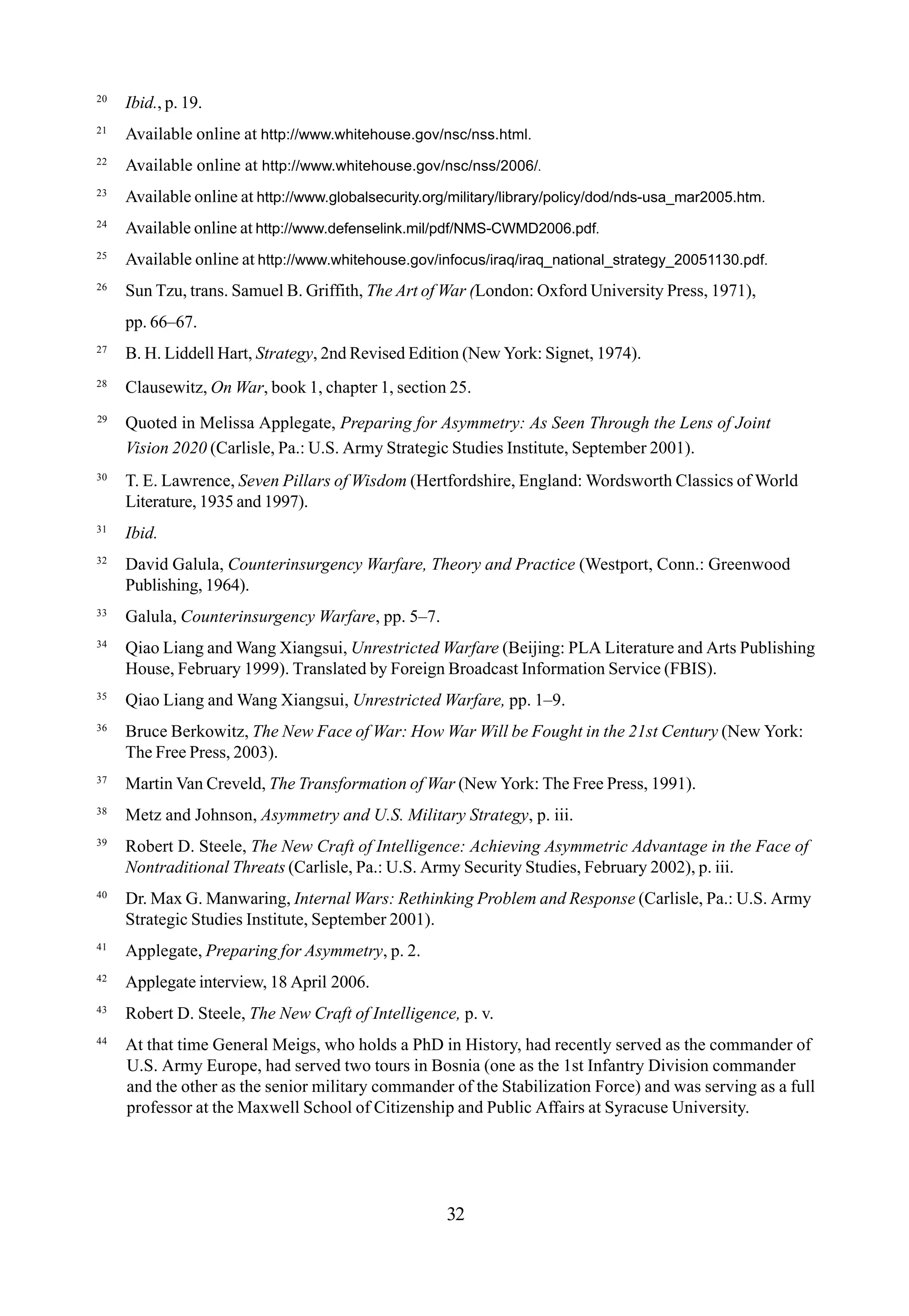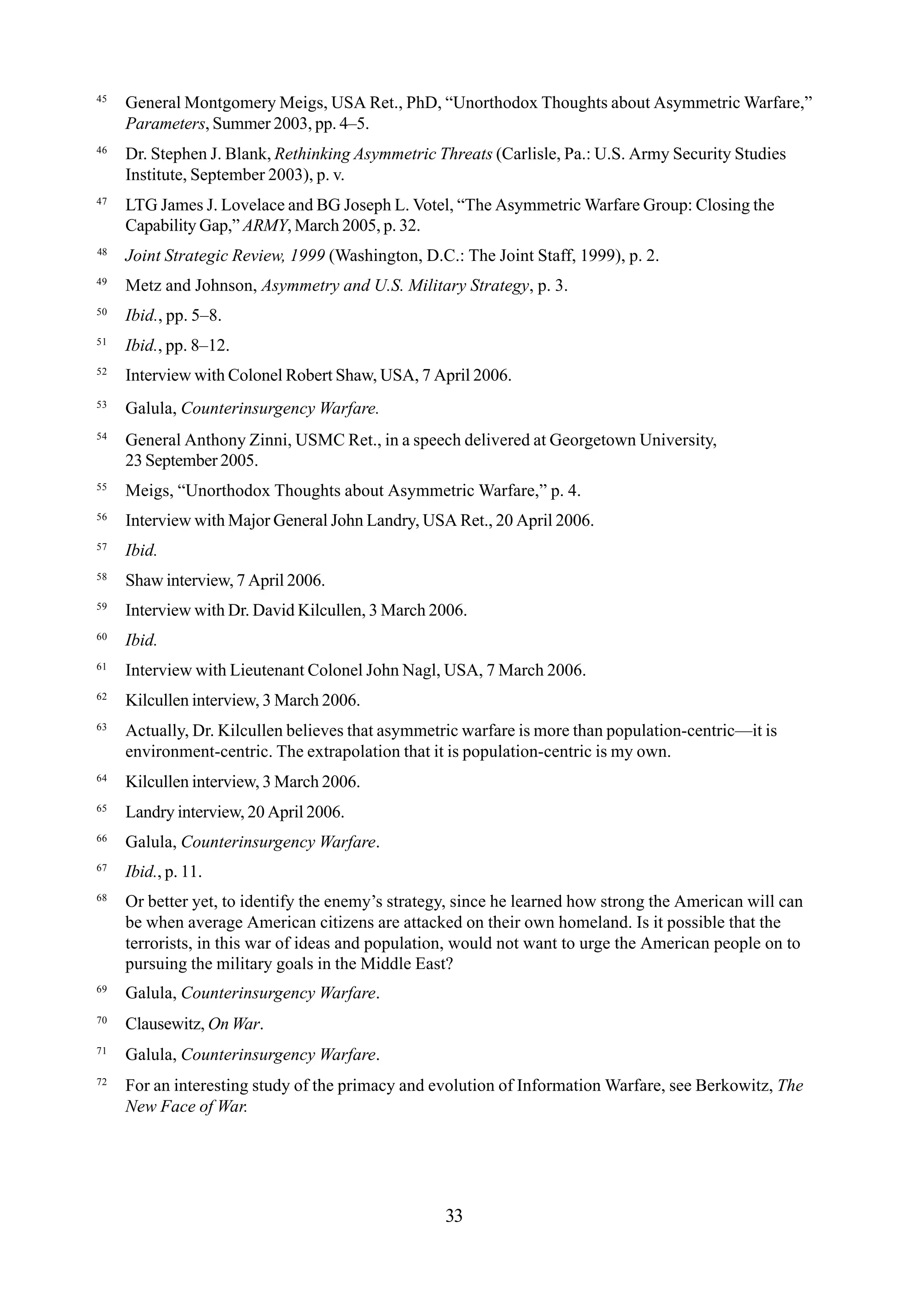The paper 'Defining Asymmetric Warfare' by David L. Buffaloe explores the evolving nature of warfare, particularly in the context of asymmetric engagements that challenge conventional military strategies. It critiques historical definitions and recent adaptations of the term within U.S. military documents, emphasizing the need for a clearer understanding as America faces non-traditional threats. The discourse argues that while all warfare is inherently asymmetric, the term has become ambiguous, highlighting the importance of developing effective strategies to counter diverse modern threats.
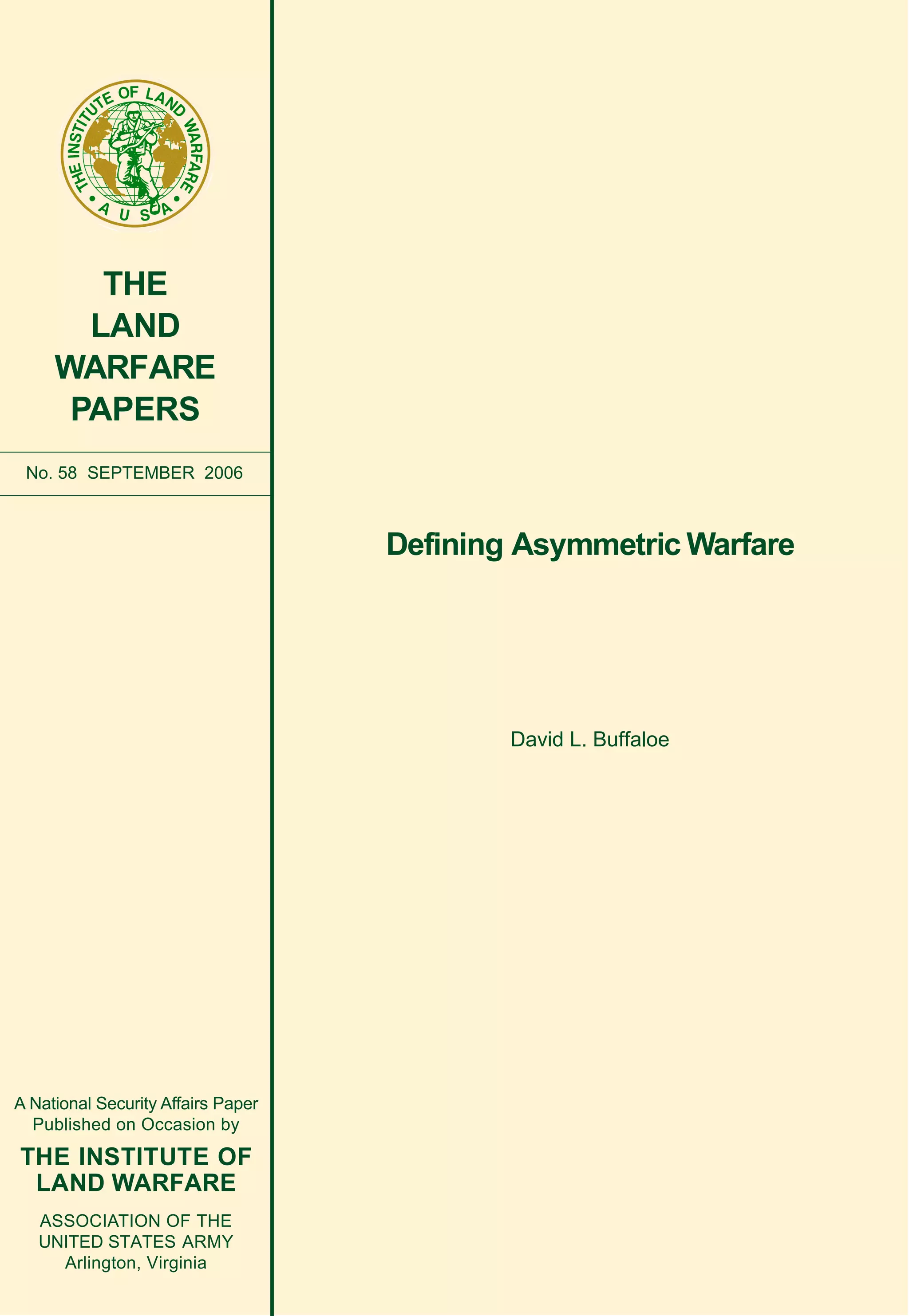
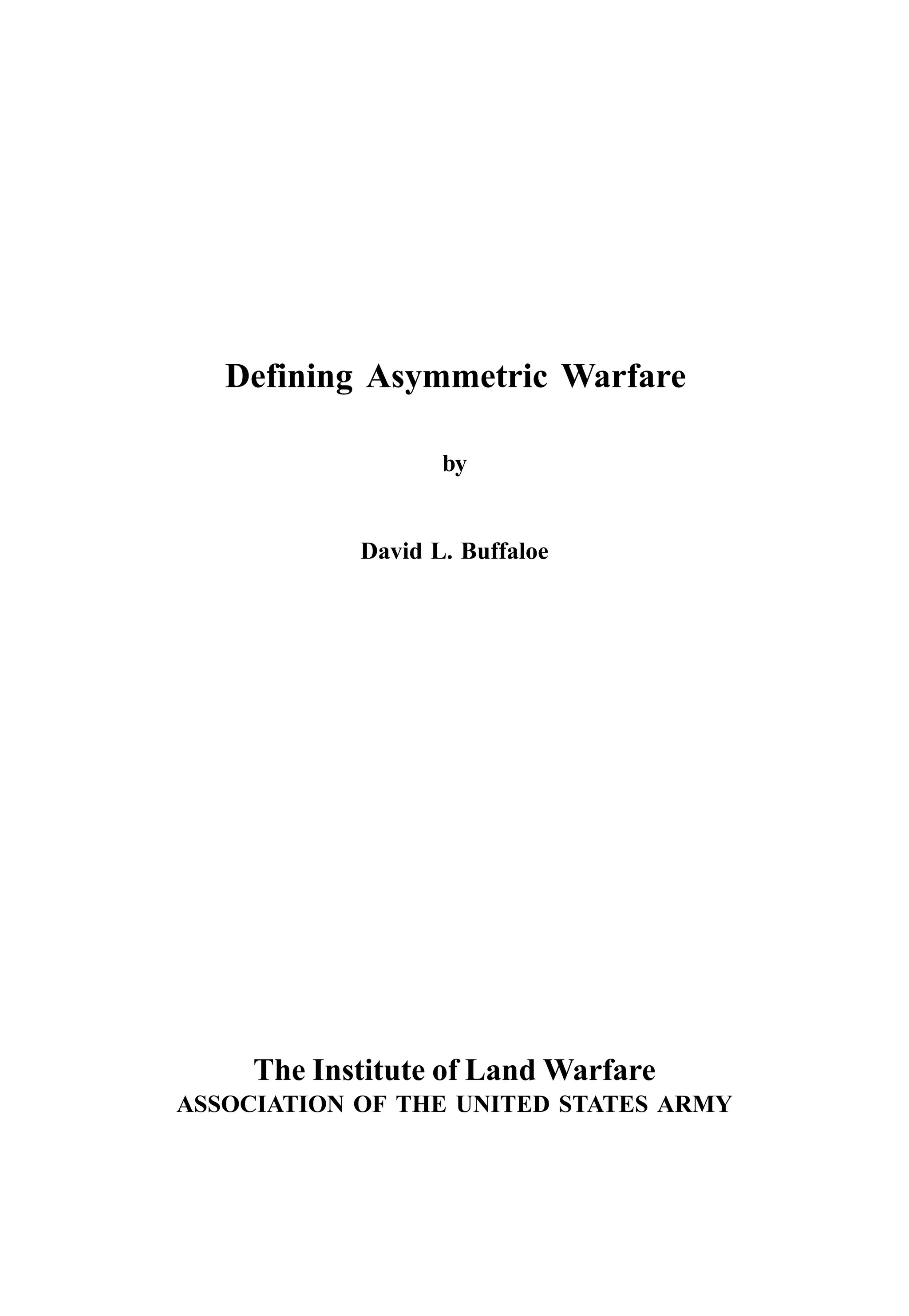
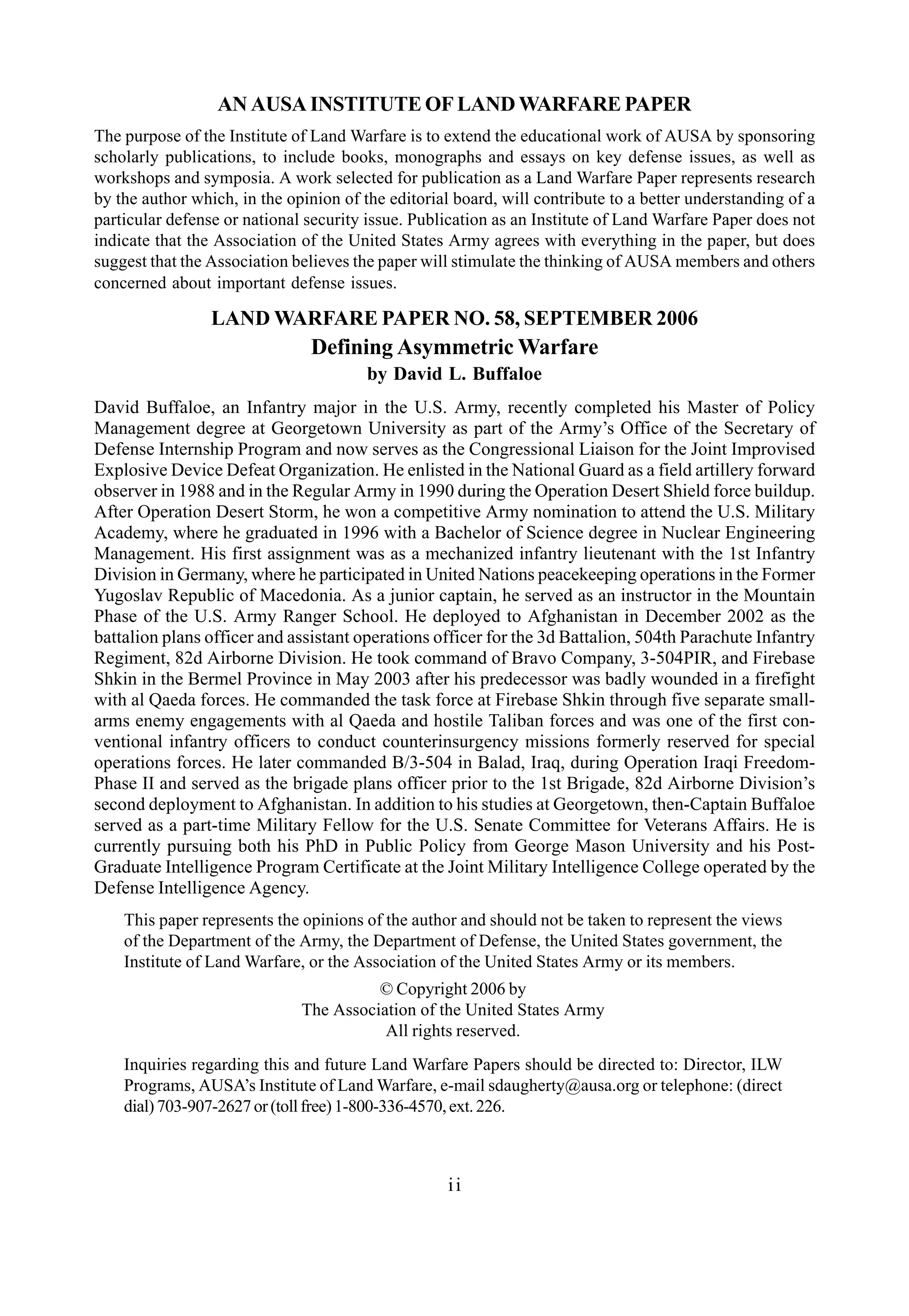
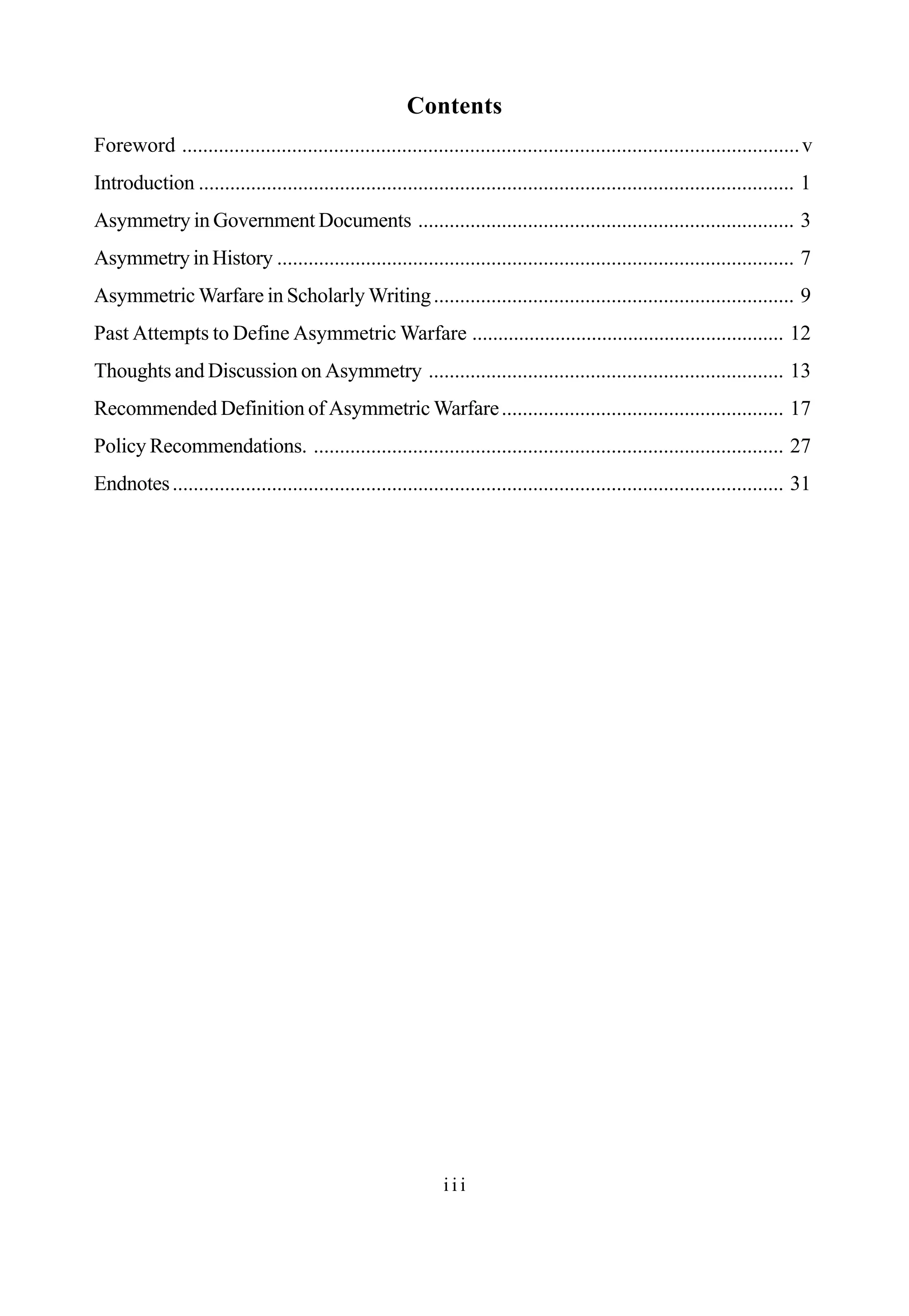

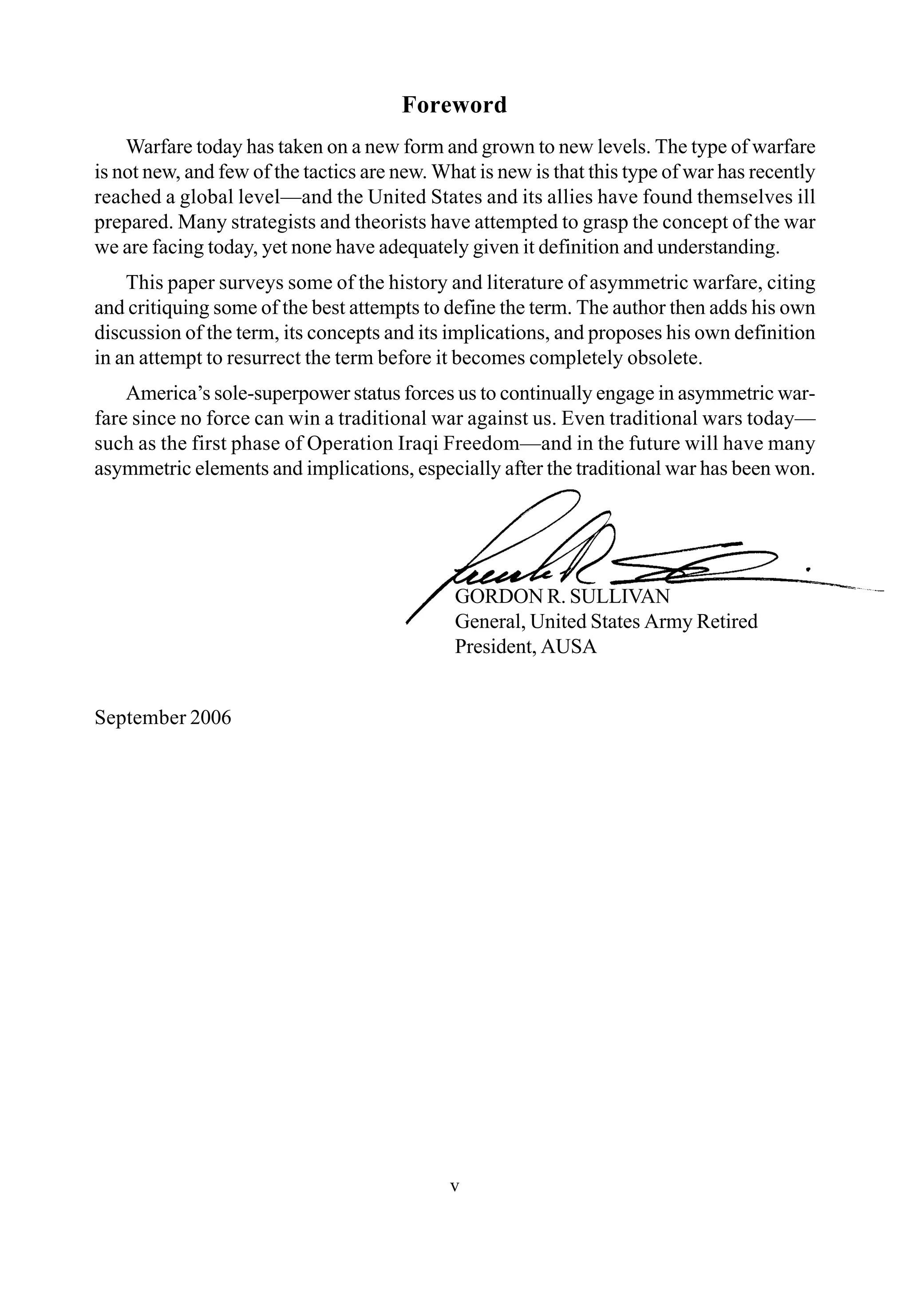

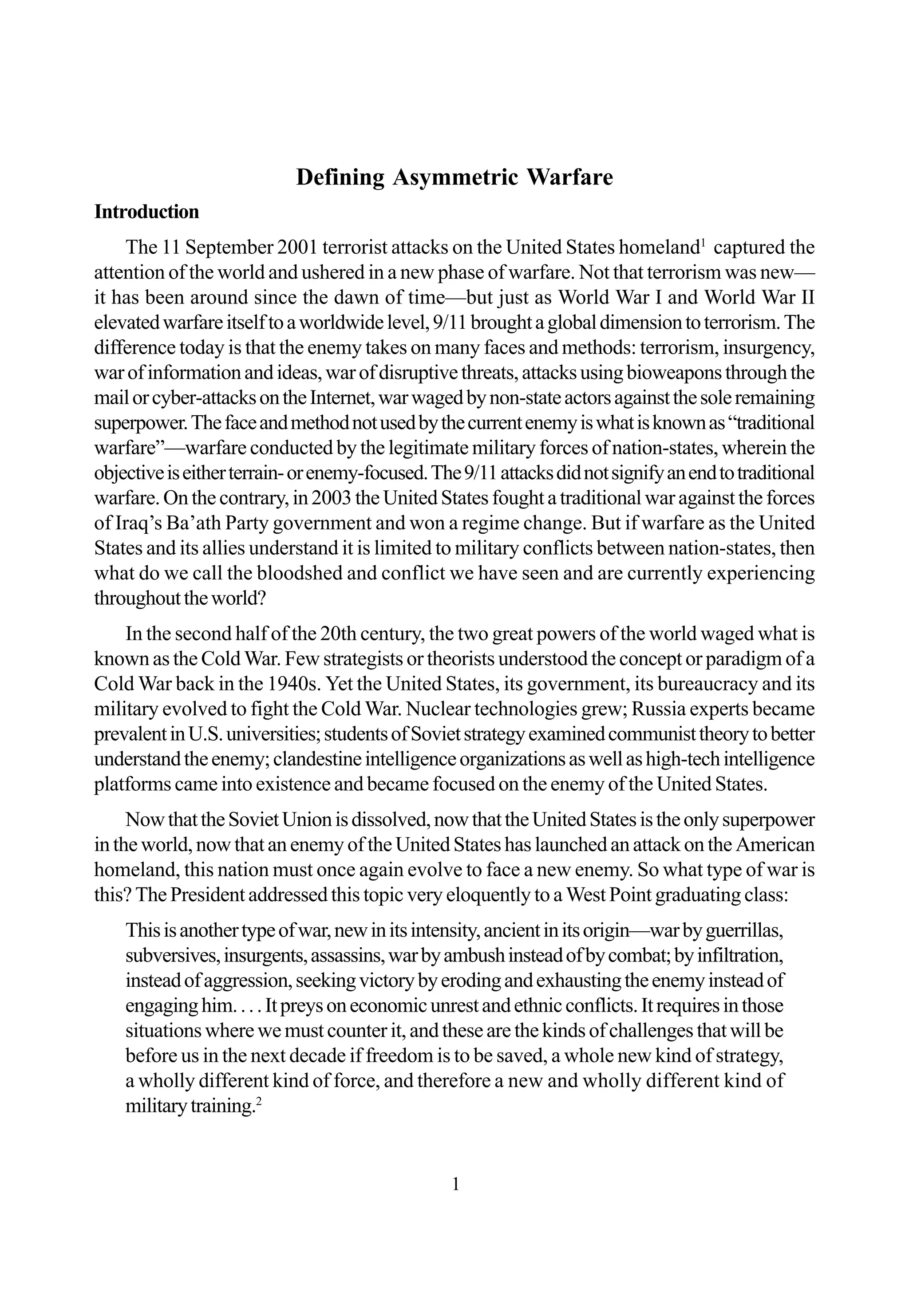

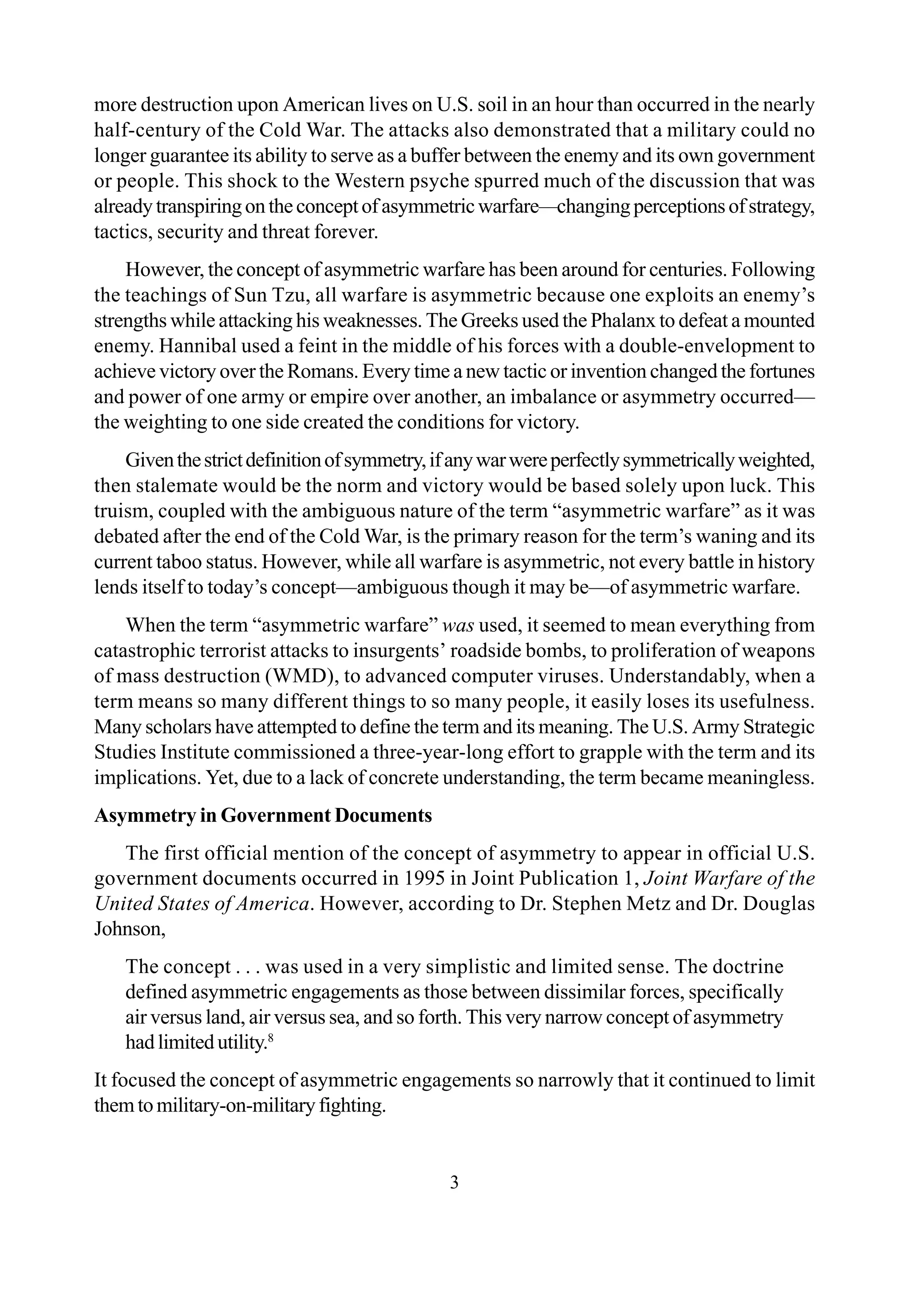
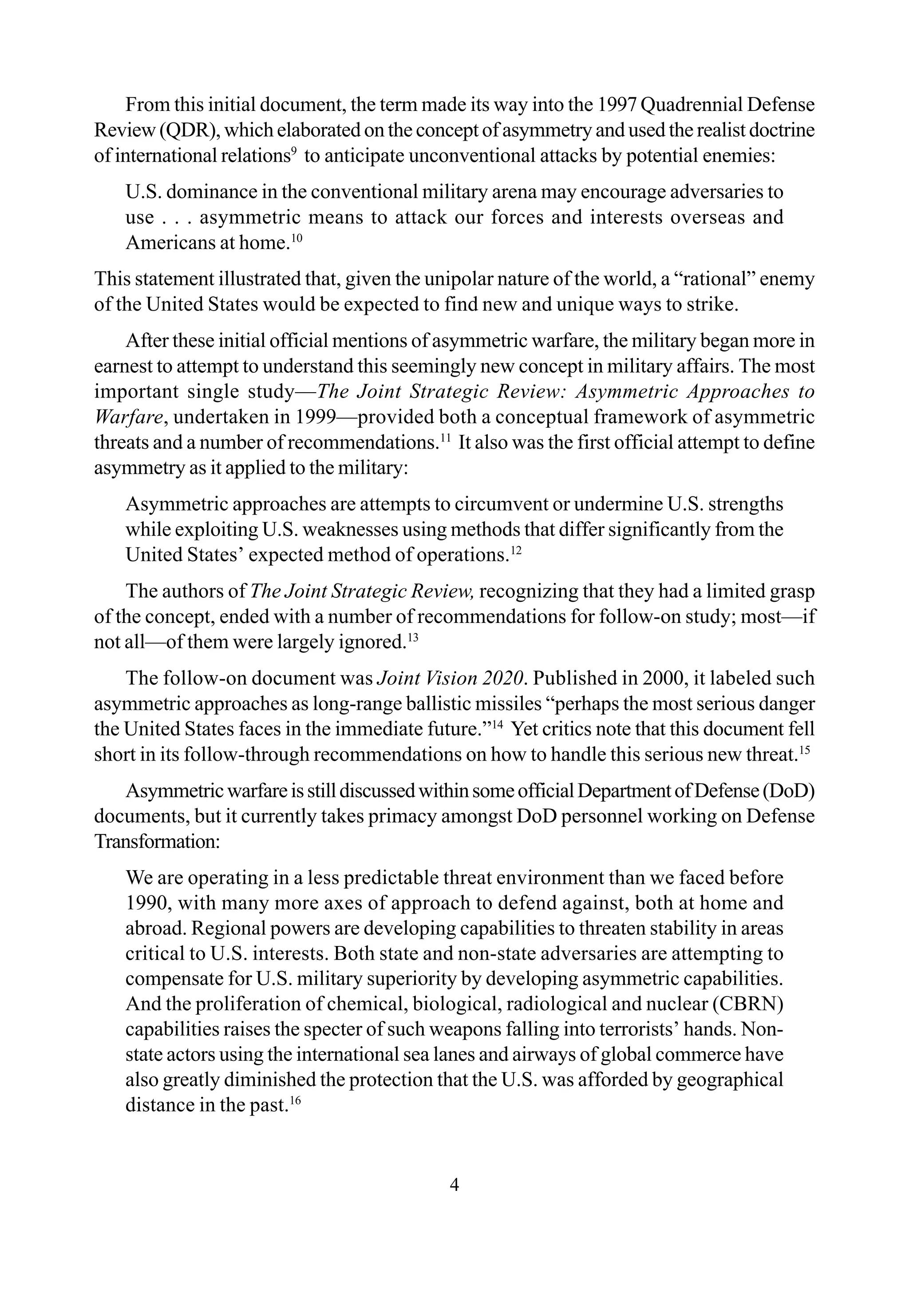
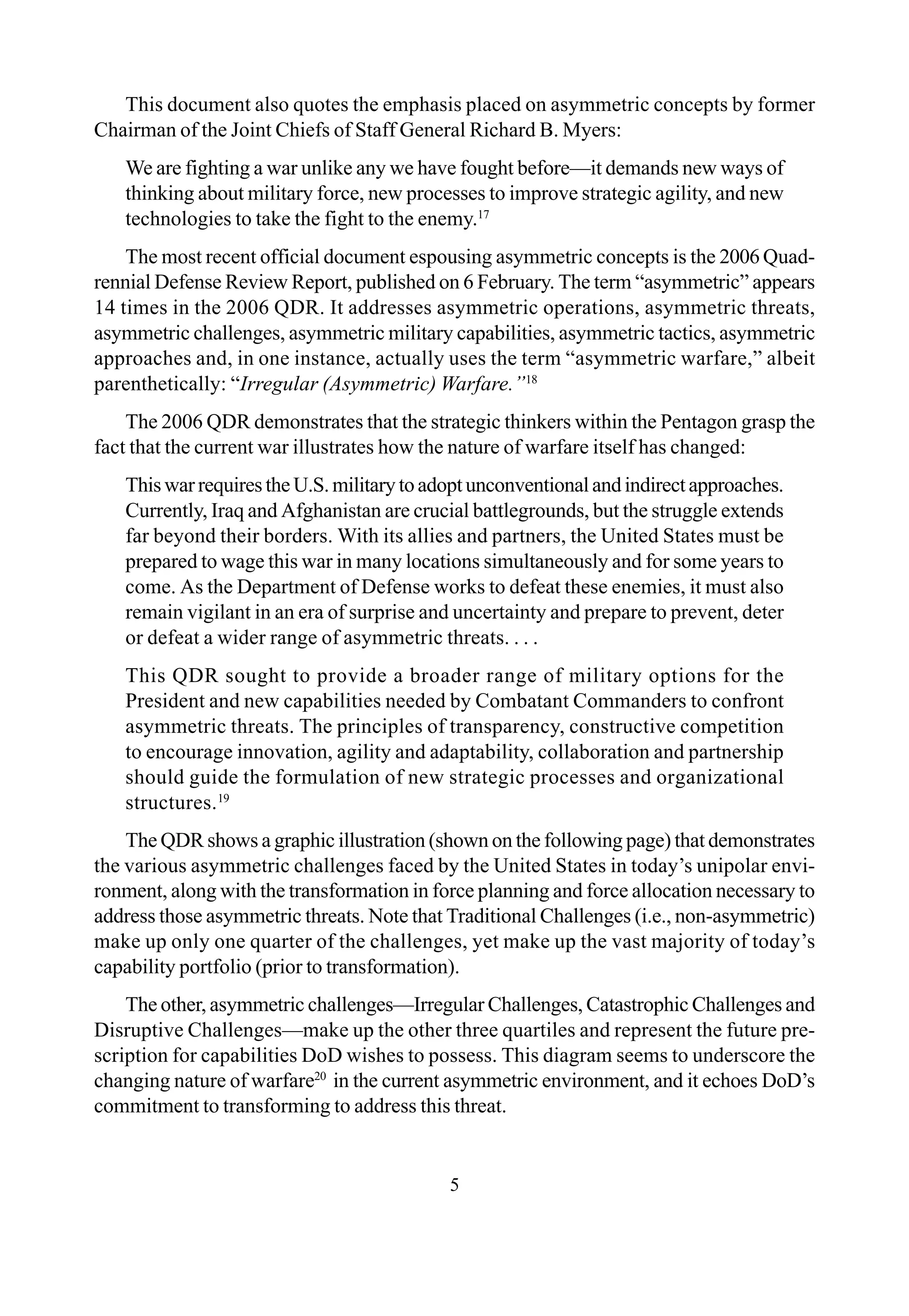
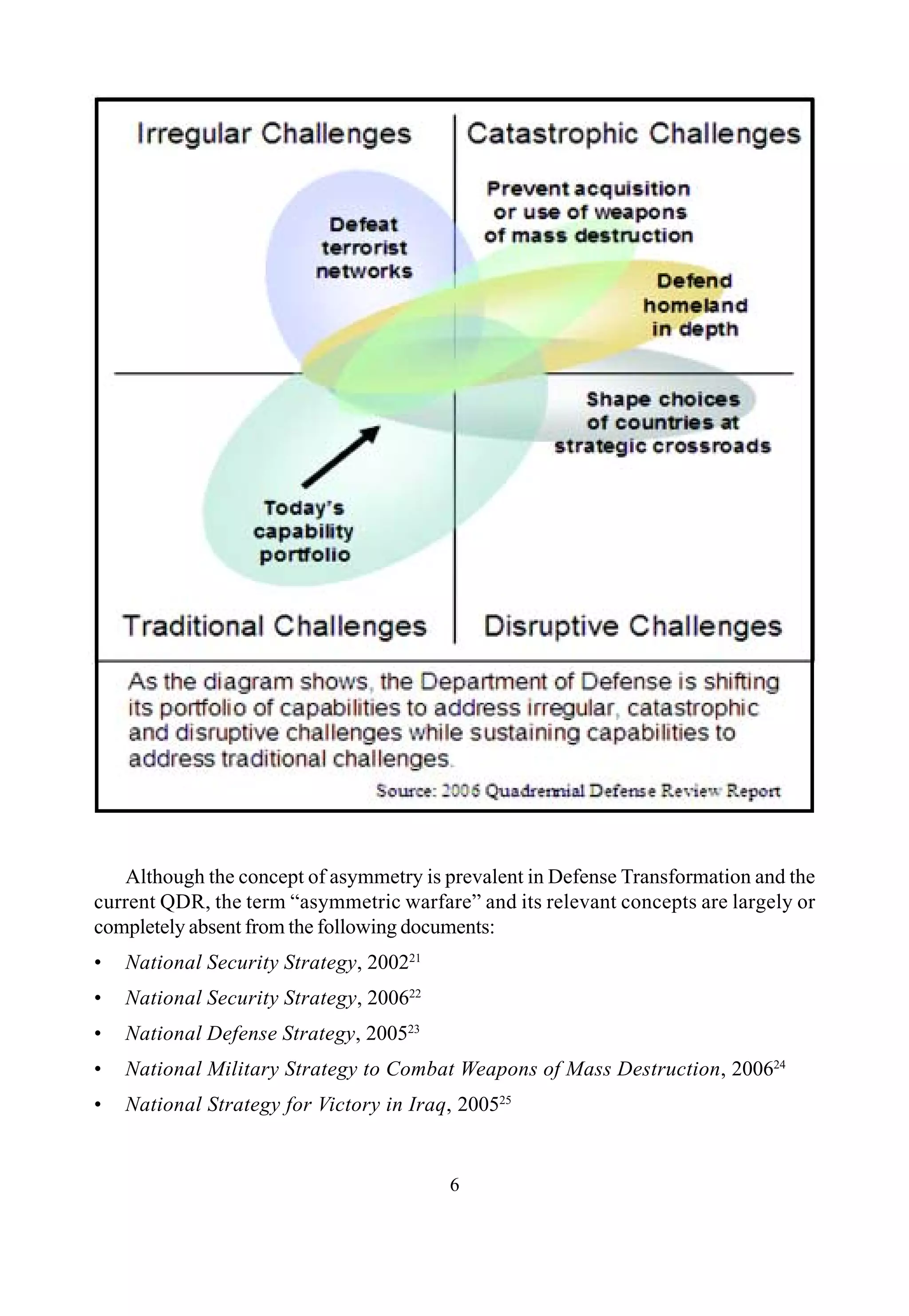
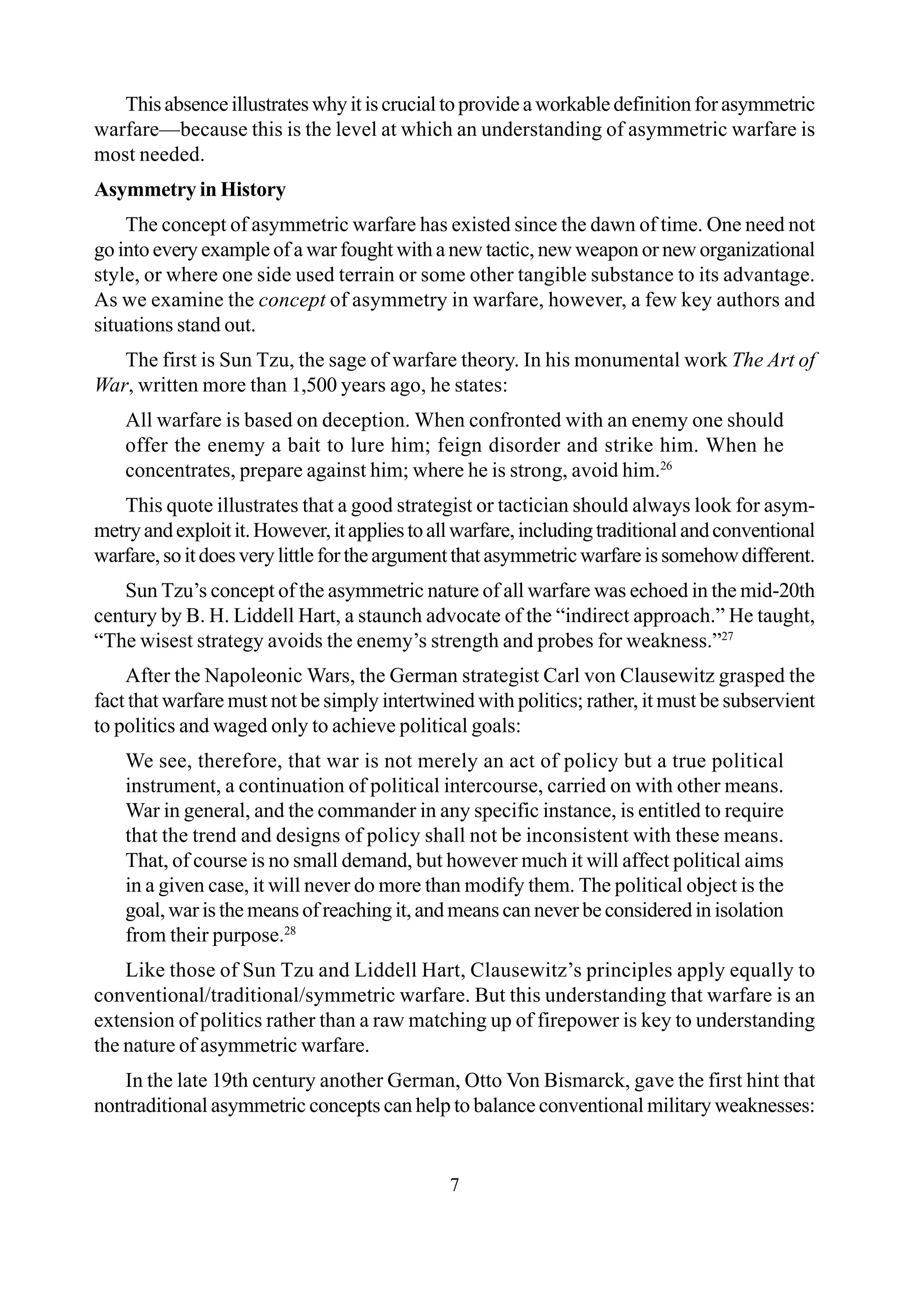
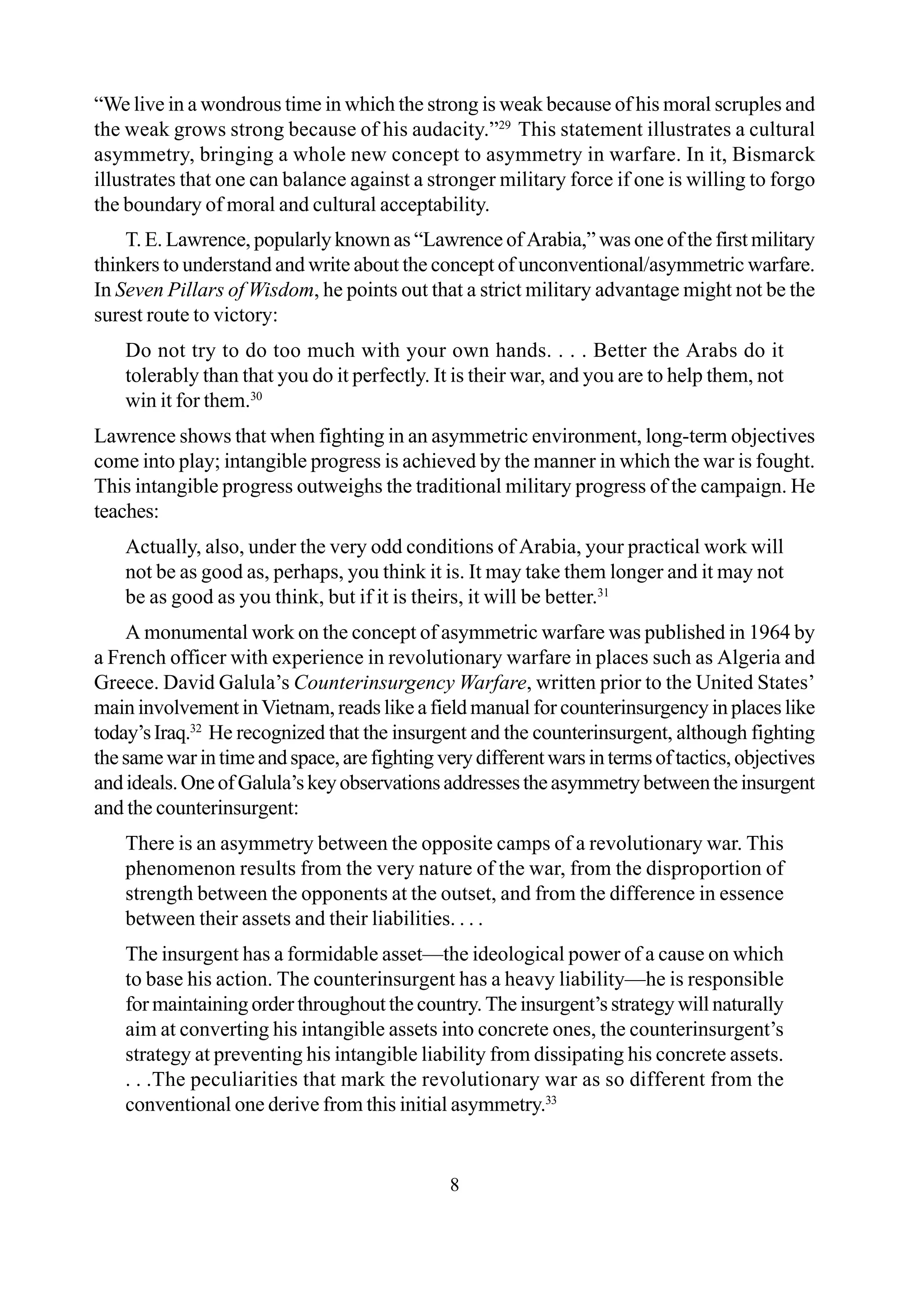
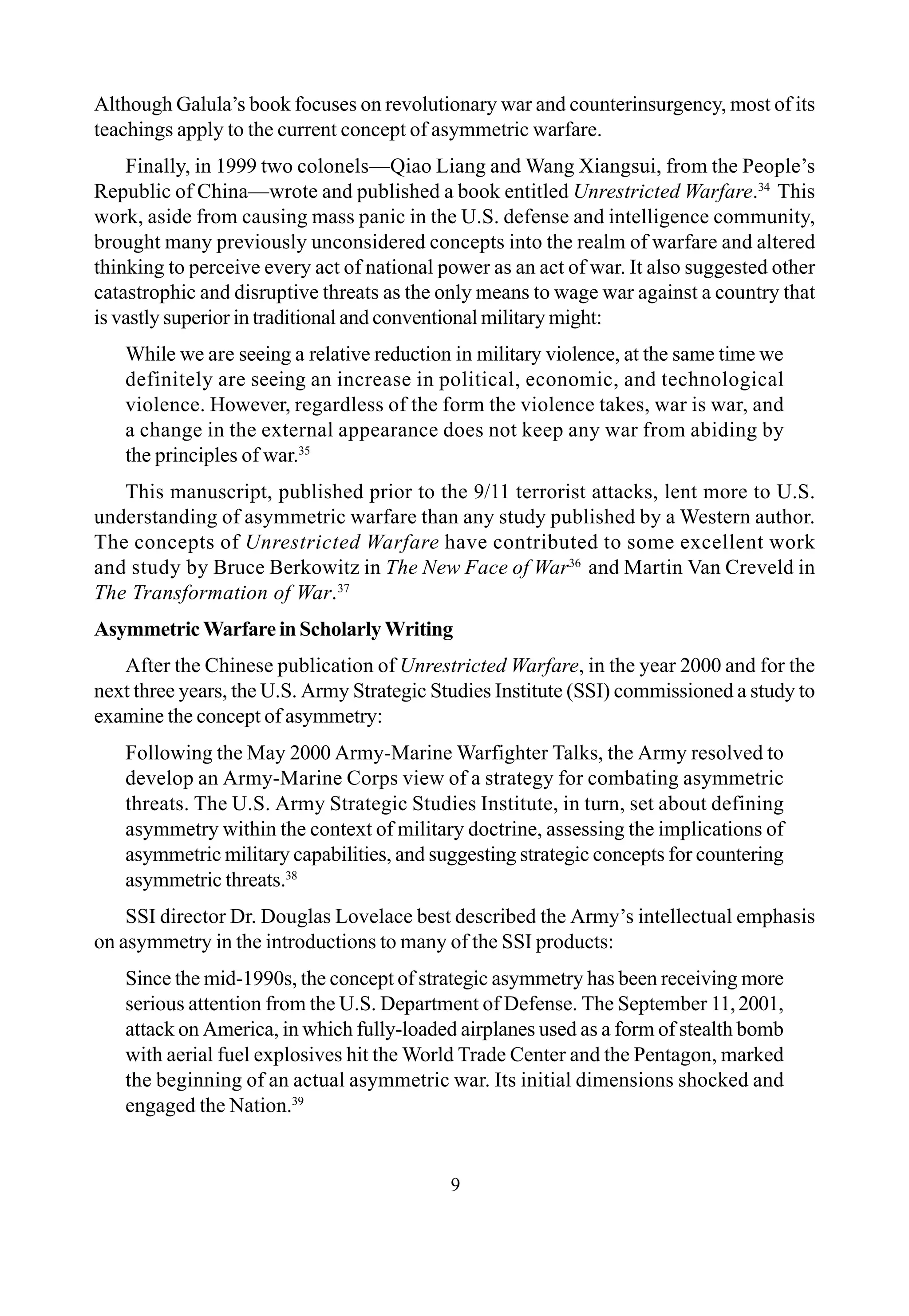
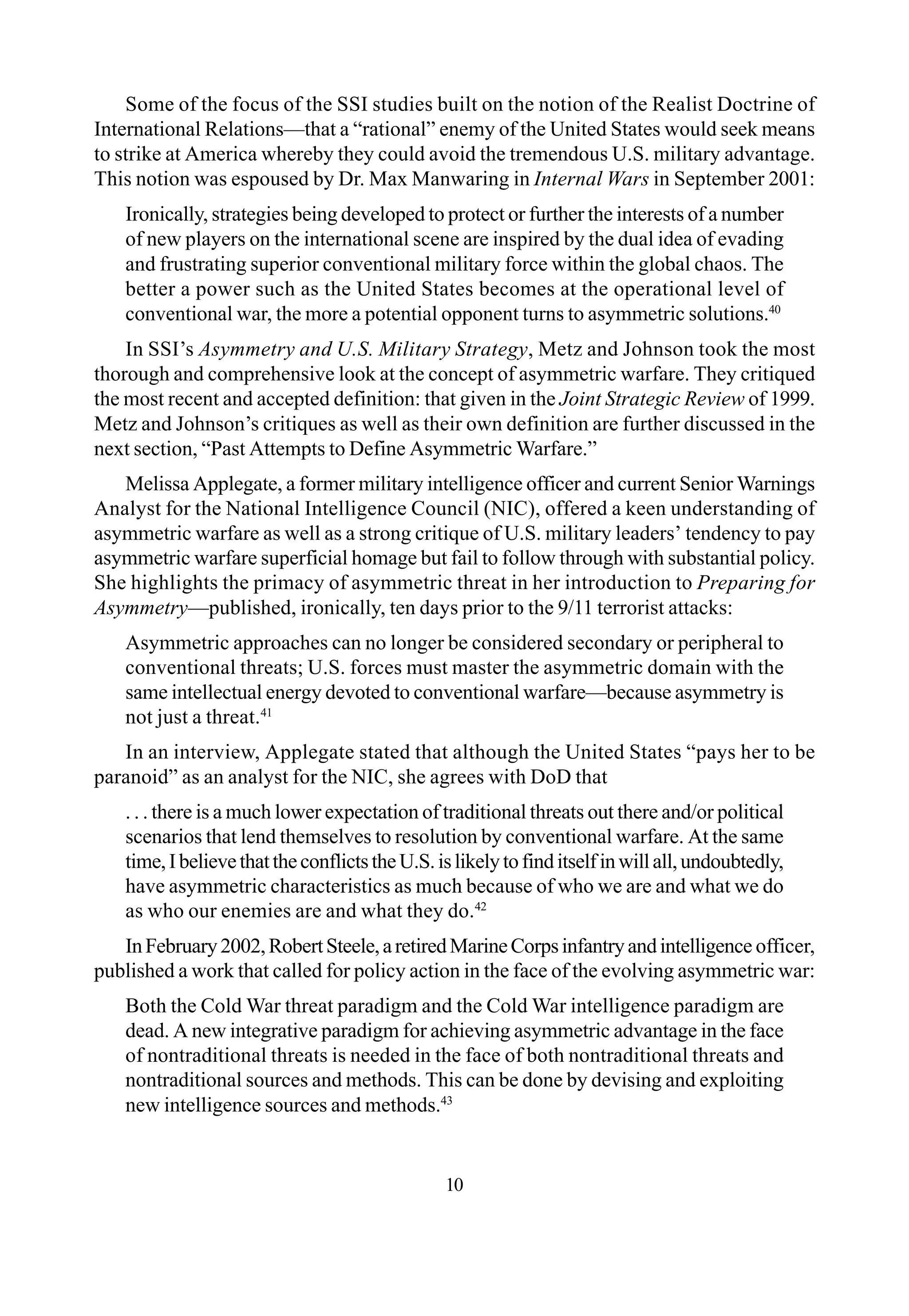
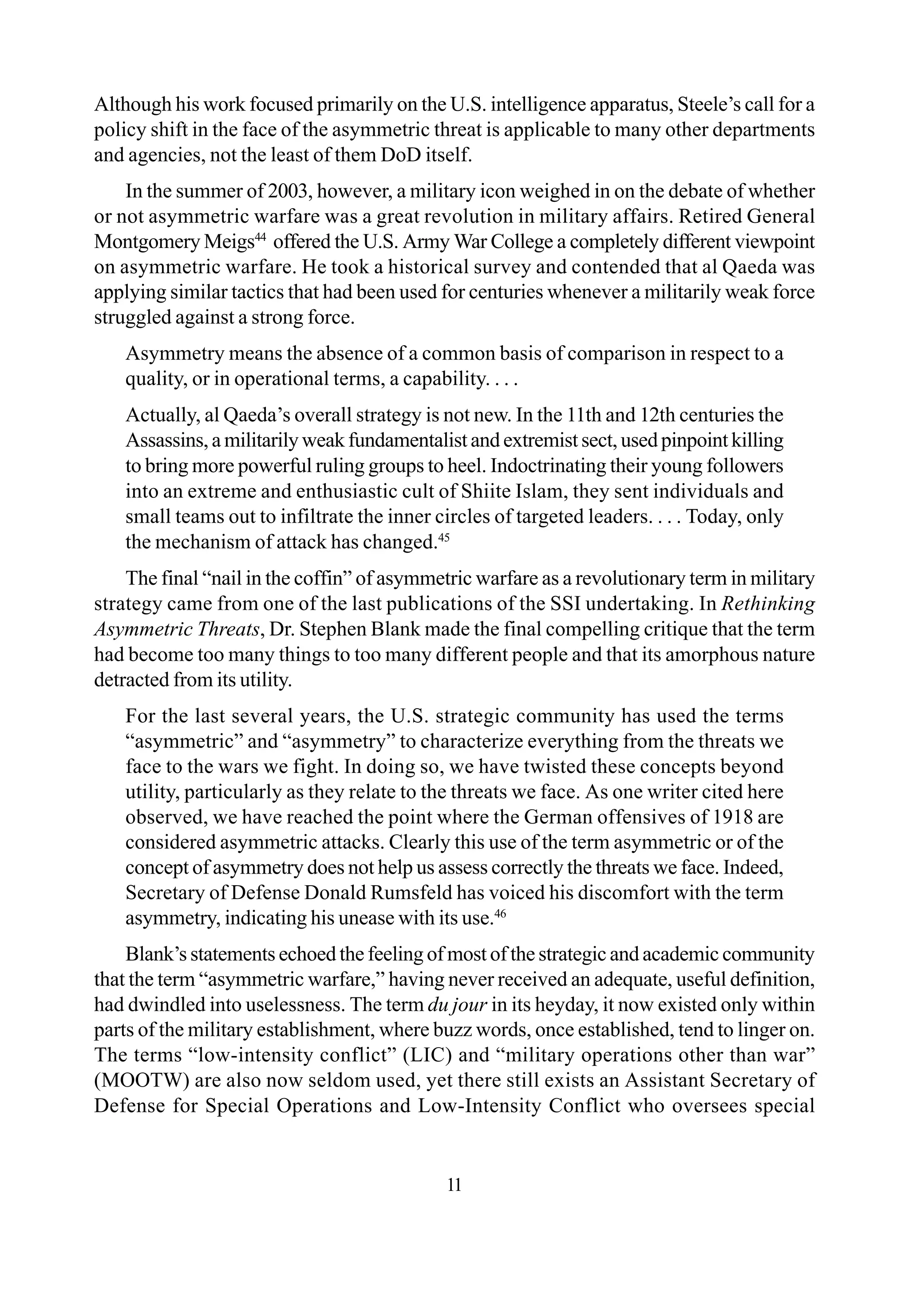
![12
operations policy, as well as a Master of Defense Analysis degree program at the Naval
Postgraduate School at Monterey, California, with a focus on special operations and
low-intensity conflict. Like LIC, the term “asymmetric warfare” still has its legacy, in a
new Army Special Mission Unit called the Asymmetric Warfare Group (AWG), which
activated on 8March 2006. As described by Lieutenant General James J. Lovelace and
Brigadier General Joseph L. Votel,
The AWG will become a lead organization in providing the conventional force
with global perspective and expertise in full spectrum training, planning and
execution of countermeasures to asymmetric warfare.47
Ironically, the AWG, although an awesome step forward in retooling the U.S. Army to
fight asymmetric warfare, focuses on specific enemy tactics and maintains its focus on the
tactical rather than the strategic level.
Past Attempts to Define Asymmetric Warfare
The first official U.S. attempt to define any notion of asymmetry appeared in the 1999
Joint Strategic Review, which defined “asymmetric approaches”:
Asymmetric approaches are attempts to circumvent or undermine U.S. strengths
while exploiting U.S. weaknesses using methods that differ significantly from the
United States’ expected method of operations. [Asymmetric approaches] generally
seek a major psychological impact, such as shock or confusion that affects an
opponent’s initiative, freedom of action, or will. Asymmetric methods require an
appreciationofanopponent’svulnerabilities.Asymmetricapproachesoftenemploy
innovative, nontraditional tactics, weapons, or technologies, and can be applied
at all levels of warfare—strategic, operational, and tactical—and across the
spectrum of military operations.48
Metz and Johnson critiqued the Joint Strategic Review definition as follows:
This definition expanded official thinking but has two shortcomings: it remains
specific to the current strategic environment and American security situation; and
it deals primarily with what might be called “negative” asymmetry—what an
opponent might do to the United States—rather than giving equal weight to how
the U.S. military might use asymmetry against its opponents.49
Their critique is valid on its second point—that when considering asymmetric warfare,
equal weight should be given to the offensive asymmetric capabilities of the stronger power.
However, their first point—that asymmetry as defined by Joint Strategic Review 1999
lacks a universal application because the definition focused on the United States—is too
harsh in its criticism. Asymmetric warfare, like an insurgency on a grand strategic level, is
a conflict that is waged very differently by the strong and the weak sides. It is not illogical
for a U.S. government document to be U.S.-focused in defining aspects of warfare. It is](https://image.slidesharecdn.com/definingasymmetricwarfarelwp58-140530103004-phpapp01/75/Defining-asymmetric-warfare-19-2048.jpg)

![14
this simple question is yes, but the actual concept of asymmetric warfare brings much
more to the understanding of the current conflict.
Asymmetry of cost. One aspect of the current asymmetric war is the asymmetry of cost.
Galula noted in 1964 the asymmetry of cost between an insurgent and a counterinsurgent.
An insurgent blows up a bridge—a counterinsurgent now must guard all bridges. An
insurgent throws a grenade into a theater—a counterinsurgent must take very expensive
steps to ensure that the population feels safe.53
This concept is drastically illustrated today
in the tremendous cost to the United States to secure its airways after the relatively
inexpensive (for the attackers) 9/11 attacks.
Asymmetry of cost is further illustrated in the cost of waging warfare in general with a
non-state terrorist organization. When a nation-state wages war against a peer nation,
each member of the conflict has similar risks at stake: population, land and interests to
defend. When a non-state actor like a terrorist organization wages war against a nation-
state, the non-state actor has no population or land at risk and therefore bears a lower
cost in waging warfare.
Culturalasymmetry. Failure to understand an enemy’s culture—assuming that the enemy
thinks as you do and shares your values—will lend to a failure to achieve victory because
you are unable to identify his “center of gravity.” General Anthony Zinni, U.S. Marine
Corps (Retired) identified the center of gravity of America’s current enemy as “angry
young Muslim men.”54
Cultural asymmetry impacts the way the West communicates—or
fails to communicate—with this center of gravity.
Asymmetry and idiosyncrasy. In his Parameters article, Meigs recommended agreeing
upon a definition, but he also recommended that strategists not overlook the idiosyncrasies
of the enemy’s methods:
Idiosyncrasy has a different connotation—possessing a peculiar or eccentric
pattern. In a military sense, idiosyncrasy connotes an unorthodox approach or
means of applying a capability, one that does not follow the rules and is peculiar in
a sinister sense. . . .
In this new strategic environment we [should] agree on a set of definitions that will
provide our tools for analysis. In preempting the terrorist are we really dealing
with asymmetry, or is something else at work? Thinking of the threat as only
asymmetric misses the mark, especially if we have the concept wrong. The
combination of asymmetry and the terrorists’ ability continually to devise
idiosyncratic approaches presents our real challenge. Assessing the distinction
and interrelationship between these two factors provides us with the initial
understanding required to address the operational challenges.55
Ambiguous definitions. Major General John R. Landry, U.S. Army (Retired) has served
as the National Intelligence Officer for Military Issues for most of the post-Cold War era,](https://image.slidesharecdn.com/definingasymmetricwarfarelwp58-140530103004-phpapp01/75/Defining-asymmetric-warfare-21-2048.jpg)
![having been appointed to the National Intelligence Council in 1993. He is not a fan of the
term “asymmetric warfare,” but he has stated that he is willing to be convinced.56
Part of
his reservation about the term is that its lack of proper definition has resulted in considerable
cloudingofcrucialintellectualjudgment:“Terminologyisimportant.Arewefightingterrorism
or are we truly fighting a global-transnational insurgency?” He posits that terminology is
important because one fights an insurgency very differently than one fights terrorists.57
Multidimensionalwarfare.Shaw cited the multidimensional nature of asymmetric warfare:
Whereas traditional warfare is linear in nature, Asymmetric Warfare is multi-
dimensional and amorphous. One category blends into the other. One action affects
the other. The “threat grid” depicted in the [2006] QDR is somewhat inaccurate
because the lines between the various threats: catastrophic, disruptive, irregular,
and traditional, are not solid boundaries, but rather blurred guidelines [whereby]
one category bleeds over and overlaps the other.58
Dr. David Kilcullen, a retired Australian lieutenant colonel with experience in East
Timor who is currently serving as the State Department’s Senior Strategist for the
Coordinator for Counter-Terrorism and is also one of the authors of the 2006 QDR,
elaborated on this multidimensional aspect of warfare:
Multidimensional warfare lends itself to asymmetry. For example, in Iraq today,
there are four dimensions operating at once: 1) first and foremost, a devastated
country badly in need of rebuilding, 2) counterinsurgency, 3) counterterrorism
and 4) sectarian and communal conflict. The difficulty is that if you address one of
the four, you lose ground on the other three. For instance, you cannot rebuild the
nation because of all of the violence. So do you end the violence first? Well, no,
because if you do not reconstruct the country then you add to the insurgency. If
you give power to the Shia, then you feed the Sunni violence, etc.59
Kilcullen identified the following four aspects of asymmetry but did not limit the
dimensions to these alone: asymmetry of technology, asymmetry of method, asymmetry of
interestsandasymmetryofcultureandvalues.Asymmetryoftechnologyisthemostobvious
due to the United States’ vast advantage. Asymmetry of method was illustrated in the
9/11 terrorist attacks, when al Qaeda proved its ruthlessness and resolve. The U.S.
experience in Vietnam illustrated an asymmetry of interests, since the U.S. goals and the
goals of the Viet Cong were very much at odds.60
Irregular warfare. Even as the term “asymmetric warfare” approaches scholarly taboo,
“irregular warfare” seems to be coming more into vogue—and, like asymmetric warfare,
irregular warfare has not been strictly defined. One concise definition—“not regular
warfare”61
—was provided by Lieutenant Colonel John Nagl, U.S. Army (Ph.D., author
and Military Assistant to the Deputy Secretary of Defense). However, once again, this
ambiguity demands some attention. Given the QDR force-planning grid, “irregular
15](https://image.slidesharecdn.com/definingasymmetricwarfarelwp58-140530103004-phpapp01/75/Defining-asymmetric-warfare-22-2048.jpg)
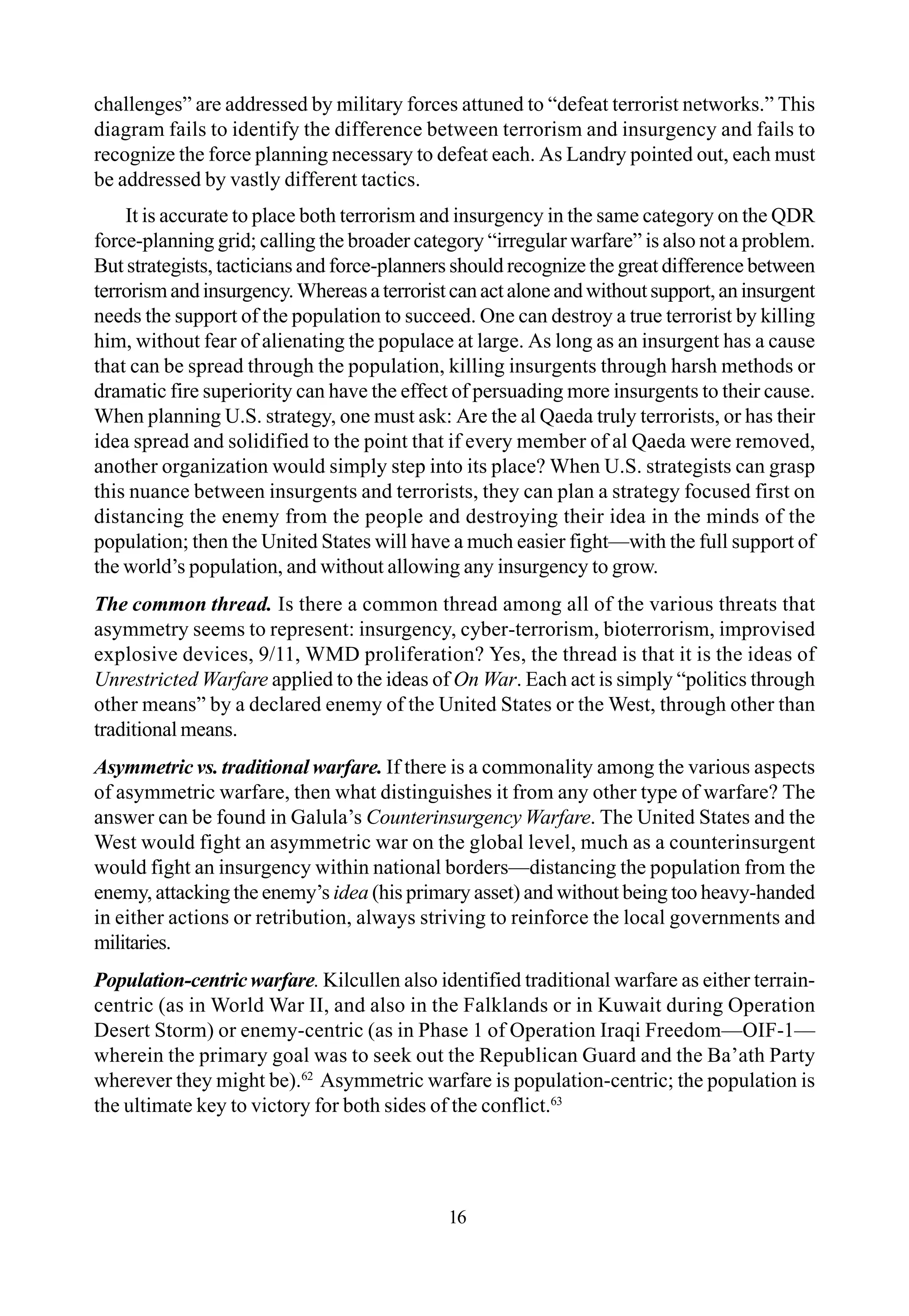
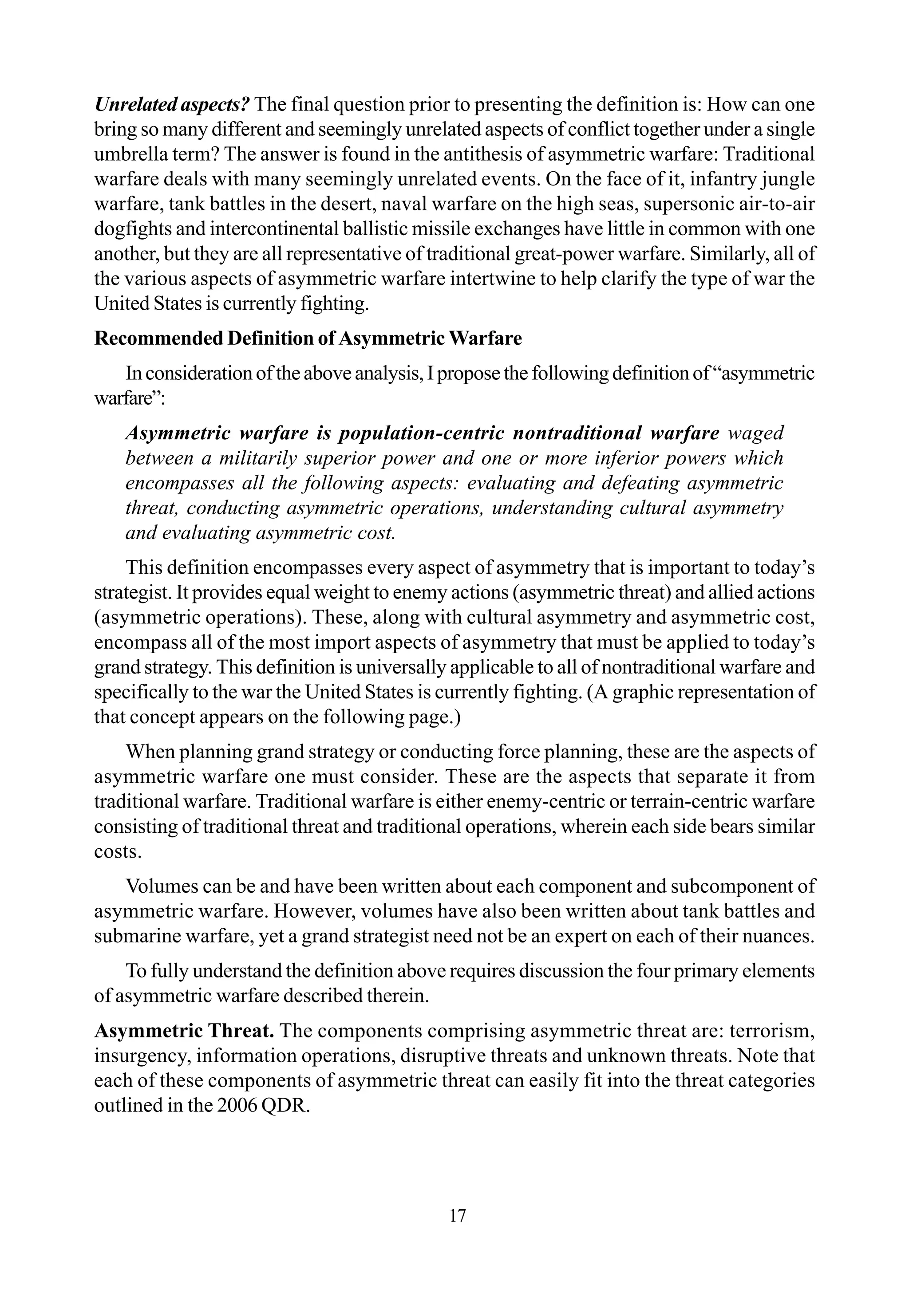

![Kilcullen mentioned that one key difference between the insurgency taking place in
Iraq and past examples of insurgency is that the Iraqi insurgency is decentralized. In
Vietnam, for instance, all of the direction of the insurgency came from Ho Chi Minh. In
Iraq, however, there are at least 17 insurgent organizations and four terrorist organizations
that the United States is aware of, many of them at odds with one another as well as with
the counterinsurgent forces.64
Also, Landry pointed out that many of al Qaeda’s actions
and strategies more closely resemble those of a global transnational insurgent than of a
terrorist. Much more like a revolutionary than a terrorist, Osama bin Laden conducts his
actions to attempt to gain the support of a populace.65
Information operations. Galula stated in Counterinsurgency Warfare that information
operations (IO) are key. An insurgent’s greatest asset is an idea; he wants to spread this
idea and convert it into more tangible assets like soldiers and support. Similarly, in today’s
asymmetric war, the United States is fighting a war of ideas wherein the Muslim population
is the objective. In this war, information operations are key. In the Information Age, a
terrorist network or a weak insurgent need not have extensive funding to have his message
heard; bin Laden can easily issue a fatwa by having one operative publish it on the Internet.
The enemy wages information warfare by issuing propaganda, creating lies and
developing conspiracies. The enemy, like the insurgents described by Galula, can bank
currency on mere promises, rather than upon action.66
They can also seek always to drive
a wedge between the target population and the West. This was clearly exemplified by the
violence that followed the publication of the Danish cartoon depicting the Prophet
Mohammed.
Disruptive threat. “Promoting disorder is a legitimate objective for the [asymmetric
enemy].”67
Between terrorism and disruptive threats lies much overlap. When conducting
a disruptive strike, an asymmetric enemy need not even commit an action; the mere threat
of action is enough to disrupt the American way of life. This holds true in the United
States, but even more so in parts of the world where suicide bombing is part of daily life.
The impact of a disruptive strike is measured in psychological rather than physical effect.
Disruptive threats weigh greatly in asymmetric cost, as will be discussed later.
A grand strategist combating disruptive threats must consider that until the average
American truly understands the nature of asymmetric warfare, great measures—at a great
cost—must be taken to make people feel safe. A strong case in point is the 9/11 terrorist
strikes: Billions of dollars were lost in impeded air travel shortly after 9/11, and billions
more have been spent to ensure that “9/11 could not happen again.” However, 9/11 could
not possibly have happened again—not even again on 9/11.The first strikes were possible
only because the terrorists broke their own paradigm. Until 9/11, every passenger, airline
employee and federal agent could be reasonably assured that when a terrorist hijacked an
airplane, he would force it to land in some neutral or friendly location, and then use the
hostages to barter for his demands; if the hostages remained calm and did not resist, they
19](https://image.slidesharecdn.com/definingasymmetricwarfarelwp58-140530103004-phpapp01/75/Defining-asymmetric-warfare-26-2048.jpg)
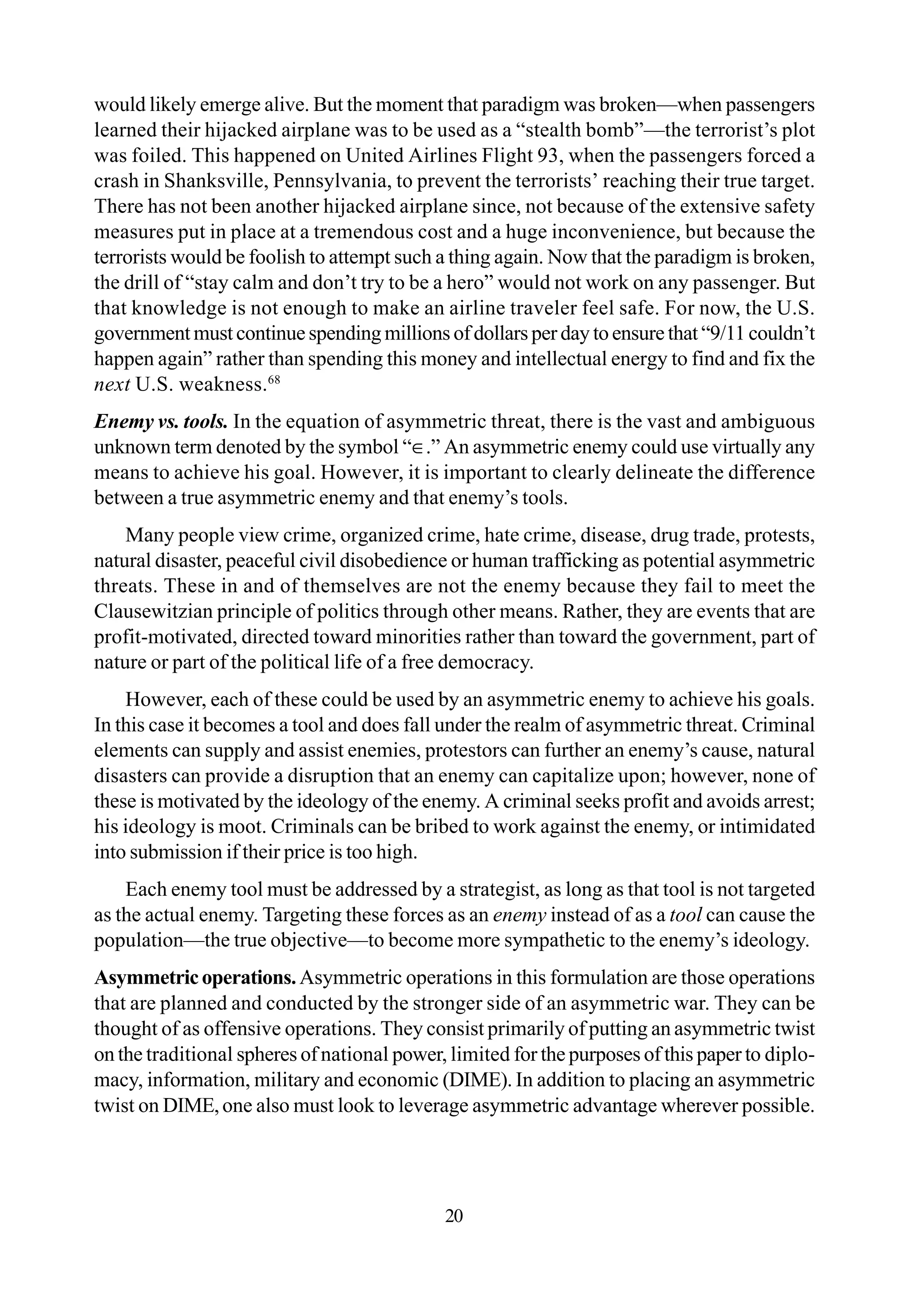
![Asymmetric diplomacy. As Galula pointed out that politics has primacy in an
insurgency69
—and Clausewitz pointed out that all wartime objectives are political70
—
diplomacy has primacy in asymmetric war. This is sometimes easy to forget since most
asymmetric enemies are non-state actors. However, if counterinsurgency principles are
applied to asymmetric warfare on the global-transnational scale, the population is still the
objective. The State Department’s mission is diplomacy; thus far they have focused only
on nation-states and international organizations. They should be organized and equipped
to engage a target population through diplomatic efforts either directly or by working
through the legitimate governments of the nation states.
Asymmetric information operations. There are four very important concepts about
information warfare that anyone conducting an asymmetric war must understand. The first
concept is that information warfare in the Information Age is not waged just by very
specialized military units on the ground. Psychological operations (PSYOP) products are
targeted communications aimed at a specific group or demographic and delivered on a
schedule as part of a larger plan. In contrast, information operations are conducted every
time an official of the United States (or the West), whether elected, appointed or uniformed,
makes any public statement; regardless of the intended target, the message is immediately
disseminated worldwide. The second concept is that actions, or lack thereof, speak much
louder than words. As Galula stated:
With no positive policy but with good propaganda, the [asymmetric enemy]
may still win. . . . [We] can seldom cover bad or nonexistent policy with
propaganda.71
The third concept is that the IO message comes across much more convincingly when it is
delivered by a local leader rather than by a Western spokesman. Whenever possible, the
United States should engage friendly sheikhs, imams, elders and elected officials to
disseminate IO themes. The last great concept to take away is that, unlike traditional
warfare wherein any action by the friendly side is seen as progress, an “action” by the
U.S. side in an information war can just as easily impede progress or take giant leaps
backward if the consequences are not thoroughly and carefully considered.
The lead agency in information warfare should be the State Department. However,
coordination must occur at all levels, and good policy—supported by organization,
knowledge and leadership—is the most important aspect in winning.72
Asymmetricmilitaryoperations. Asymmetric military operations mainly comprise direct
action (antiterrorism), unconventional warfare (counterinsurgency), psychological opera-
tions, civil-military operations, foreign internal defense and special reconnaissance.
Ironically, until recently U.S. Army Special Operations Command trained for and special-
izedineachofthesetypesofoperations—leavingtherestoftheArmytofocusontraditional
missions. Today, however, given the nature of the asymmetric war the United States is
fighting, the rest of the military is quickly learning to perform of these operations.
21](https://image.slidesharecdn.com/definingasymmetricwarfarelwp58-140530103004-phpapp01/75/Defining-asymmetric-warfare-28-2048.jpg)

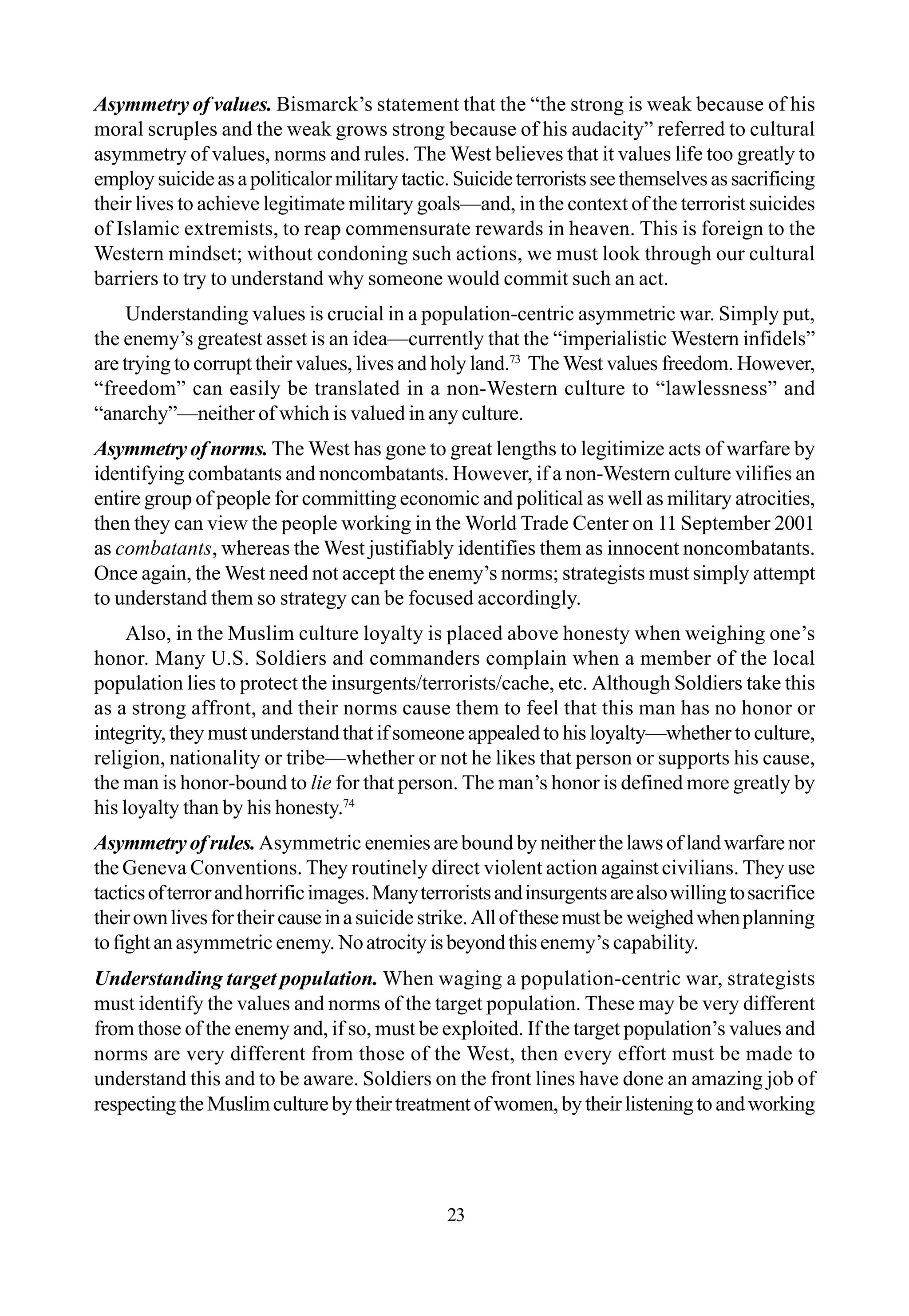
![with sheikhs and village elders; this now must occur at every level. When U.S. values of
“freedom of the press” conflict with the target population’s notion of a “travesty against
God,” strategists need to be aware and deal with it at a national, diplomatic level; otherwise
the enemy will exploit this clash of cultures. Also, when the United States shows the world
that it trusts its European allies but not its Middle Eastern allies to operate U.S. ports, the
enemy can exploit this with the target population.
Informationoperations. Cultural asymmetry is crucial in waging information warfare.
As previously stated, information warfare is waged whenever any Western spokes-
person makes a public statement and any time the West acts or fails to act in a given
situation. Often, Western leaders make statements for their own benefit and without
consideration of their impact on this war’s target population. Statements such as “I would
rather fight them over there than over here” tell an Iraqi who is deciding whether to
support the insurgents that the goal of the United States is to make Iraq (his home)
an unending battleground. Courses on communicating with the Muslim world can and
should be taught to any Western spokesperson.
Asymmetric cost. Galula quite eloquently explains that there is a tremendous cost to
asymmetry in counterinsurgency warfare; this is true in all types of asymmetric warfare:
Disorder . . . is cheap to create and very costly to prevent. . . . Because [we)]cannot
escape the responsibility of maintaining order, the ratio of expenses between [us]
and the [asymmetric enemy] are high. . . . Because of the disparity in cost and
effort, the [asymmetric enemy] can thus accept a protracted war; [we] should
not. . . . The [asymmetric enemy] is fluid because he has neither responsibility nor
concrete assets; [we are] rigid because [we have] both.75
Asymmetric cost encompasses assets at stake, cost of asymmetric defense, cost of
undertaking action, and the asymmetric costs and nature of information operations.
Assets at stake. As stated previously, a nation state that goes to war places many assets
at risk: population, land and interests. A non-state actor’s or an insurgent’s only asset is
his idea; he has no land or population. He may have interests, and he probably has a
target population. The goal of the players on both sides of an asymmetric war, as in a
counterinsurgency, is to win over the population to support their side—only then can the
enemy grow weak. If an asymmetric enemy has interests, then these interests should be
targeted as well. When fighting other than a nation-state, however, one must recognize the
assets at stake for each side of the asymmetric war.
Cost of defense. As Galula noted, “Disorder . . . is cheap to create and very costly to
prevent.”76
It is cheap for an insurgent to bomb a bridge, but expensive for a counter-
insurgent to guard all of the bridges. We have seen that it is cheap for al Qaeda to hijack
airplanes but expensive for the United States to maintain air security. It is cheap to mail
anthrax but expensive to screen the mail.
24](https://image.slidesharecdn.com/definingasymmetricwarfarelwp58-140530103004-phpapp01/75/Defining-asymmetric-warfare-31-2048.jpg)


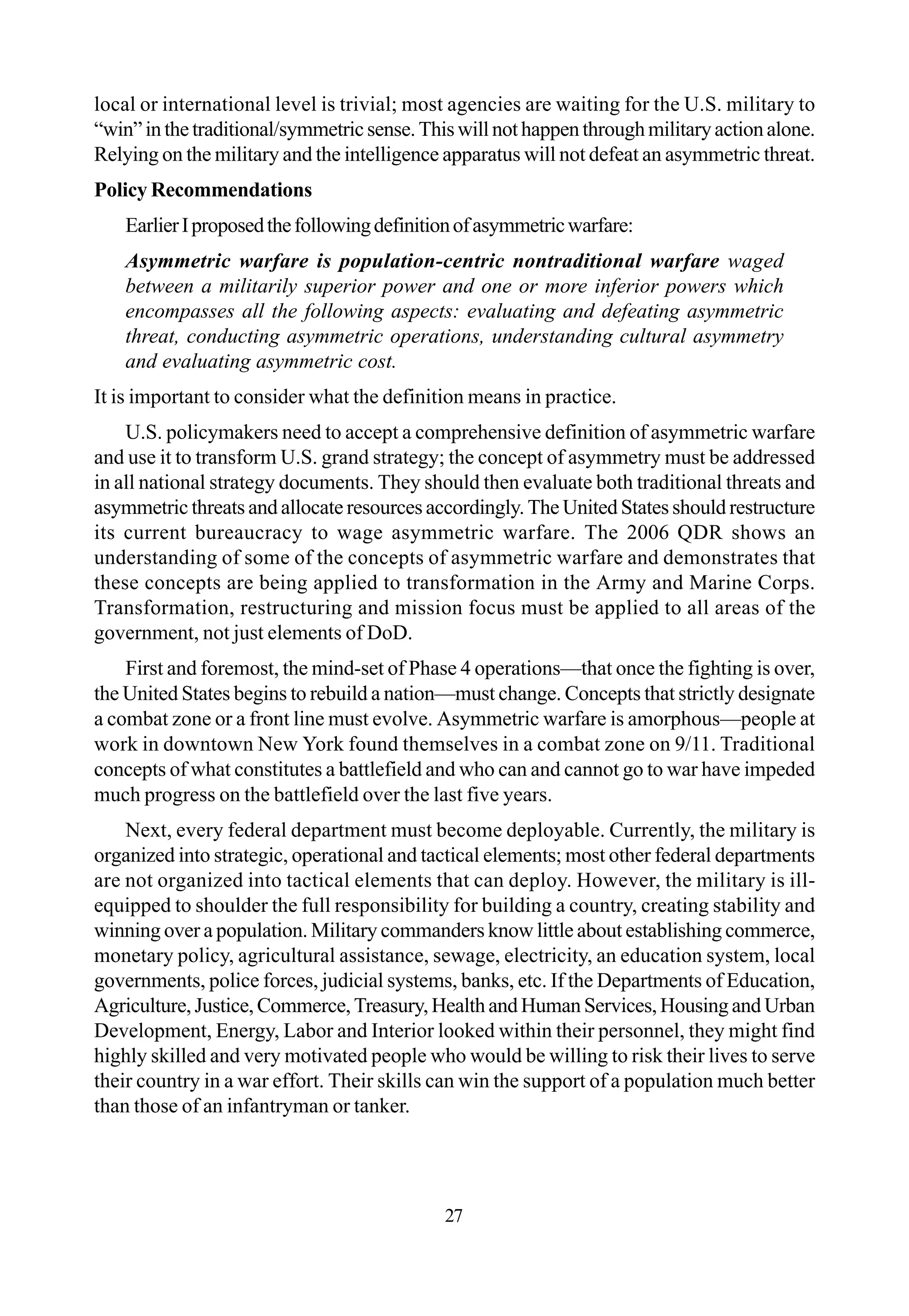
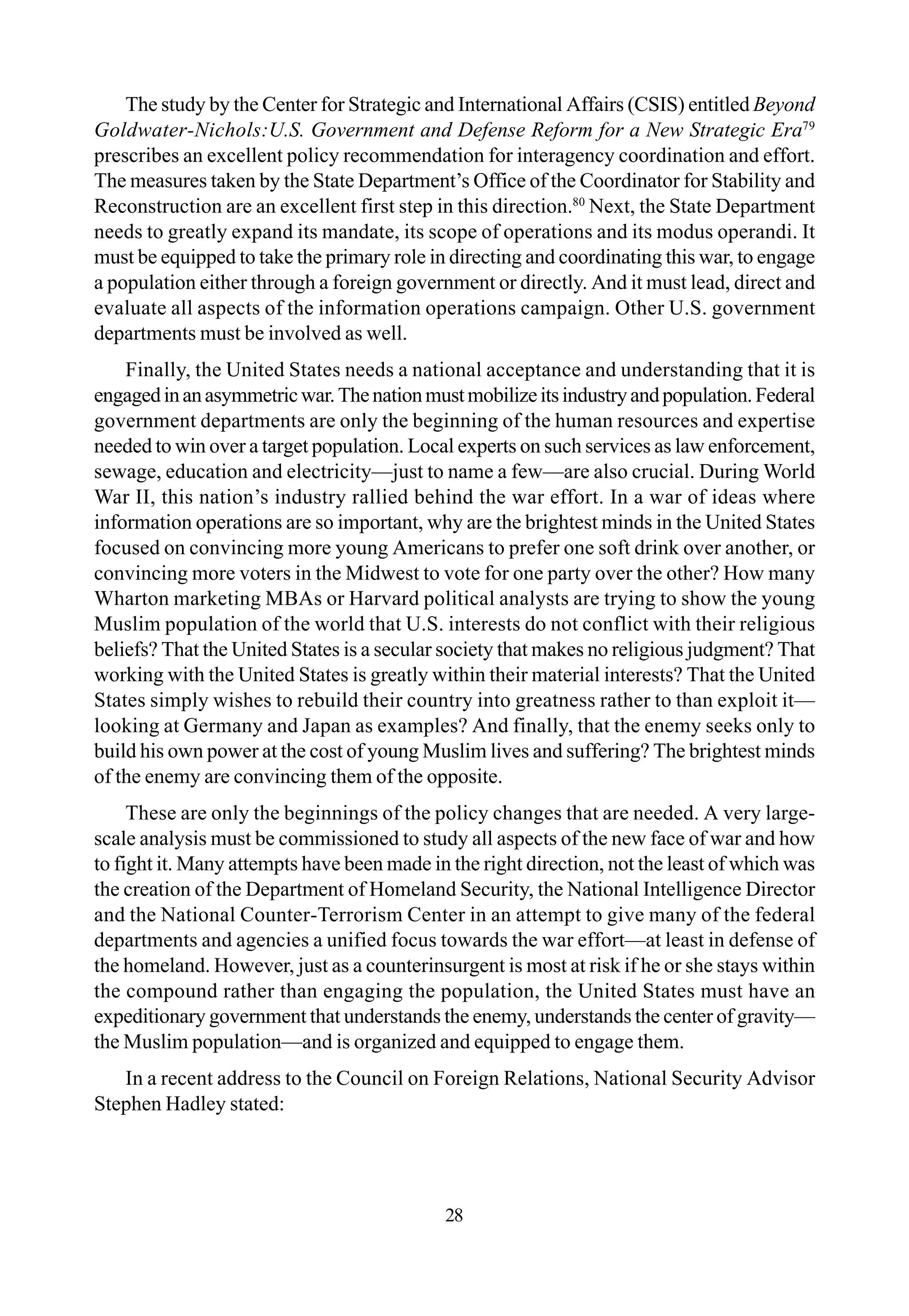
![[T]he new international environment also brought new security challenges. Instead
of great power conflict, the United States found itself confronted by a more diffuse
array of threats. The attacks on the Homeland on September 11, 2001, provided
a stark demonstration of the most serious dangers we and our friends and allies
face. A terrorist enemy showed it could attack America and kill thousands of our
citizens. This same terrorist enemy operated out of a national safe haven—
Afghanistan—where it sought to develop weapons of mass destruction and
inculcated in its recruits a murderous ideology.
Since that tragic day, the United States and its allies have waged war against al
Qaeda, its associates and supporters, and the deadly scourge of terror and
intimidation more broadly. An international coalition has taken the fight to the
enemy, targeting its leadership, denying it safe havens, and disrupting what it needs
to support its operations.81
Here Hadley demonstrates that he understands the nation is facing an asymmetric
threat, yet he fails to grasp the overall concept of asymmetric warfare. The war he sees is
enemy-centric (taking “the fight to the enemy, targeting its leadership”) and terrain-centric:
(“denying it safe havens”). He fails to mention any strategy for winning the respect and
cooperation of the Muslim community that is the enemy’s center of gravity and political
objective. He does not mention any asymmetric objective—only traditional military
objectives. He mentions the “most serious dangers that we and our friends and allies
face,” but the average Iraqi citizen is in much greater danger than the average Western
citizen—and they are the target population.
In the future, the United States could conceivably fight another traditional war—either
enemy-orterrain-focused,facinganorganizedmilitaryrepresentingthelegitimateauthority
of a nation-state. However, even traditional warfare will have asymmetric implications.
OIF-1 was a traditional, enemy-centric war fought against the organized army of a hostile
nation-state. However, OIF-1 led directly into an asymmetric conflict of epic proportions.
It is a valid assumption that any future conflict with Iran, North Korea or China not only
would be fought by both conventional and asymmetric means by the enemy but could also
have tremendous asymmetric consequences after the conventional victory.
The West is currently at a turning point. The United States could turn this war into a
victory, or it could dissolve into defeat—simply because the nation fails to recognize the
war it is fighting. Asymmetric warfare is waged differently by each side, and the victor is
not preordained. It can be won, but not by blindly charging into the fray, chasing terrorists
without concern for the effect on the population—because population is the true objective
for each side. The first step in winning a war is knowing what type of war one is fighting.
By understanding asymmetric warfare and its policy implications, the United States will
be able to effectively coordinate its actions to achieve victory.
29](https://image.slidesharecdn.com/definingasymmetricwarfarelwp58-140530103004-phpapp01/75/Defining-asymmetric-warfare-36-2048.jpg)


